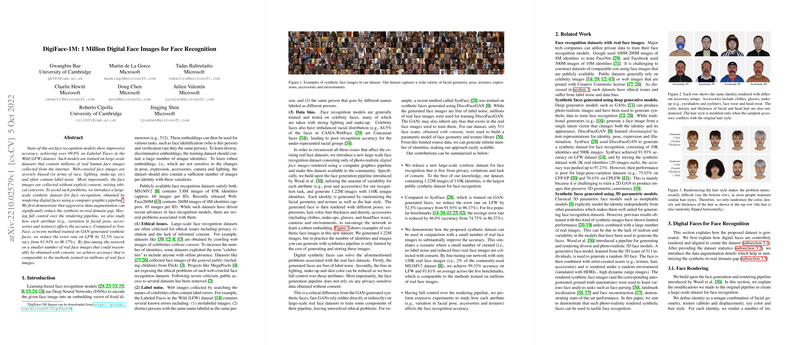An Analysis of "DigiFace-1M: 1 Million Digital Face Images for Face Recognition"
The paper "DigiFace-1M: 1 Million Digital Face Images for Face Recognition" presents the creation and utilization of a large-scale synthetic dataset aimed at addressing ethical and technical issues prevalent in current face recognition datasets. Currently, state-of-the-art face recognition models achieve unparalleled accuracy, often surpassing 99.8% on datasets such as Labeled Faces in the Wild (LFW). These models, however, are usually trained on datasets derived from millions of real human face images, which present several challenges such as ethical concerns, label noise, and data bias.
Synthetic Dataset Creation
The authors introduce DigiFace-1M, a synthetic dataset comprising over a million photo-realistic digital face images generated using a computer graphics pipeline. This approach allows comprehensive control over race, pose, accessories, and environmental conditions, mitigating the major drawbacks associated with traditional datasets. Specifically, the paper outlines how this dataset circumvents issues such as privacy violations, label noise, and racial bias.
The dataset harnesses the capabilities of a generative model informed by 511 face scans with full consent, enabling the generation of numerous unique facial identities. This renders an ethical advantage, as it does not rely on human photographs crawled from the web, unlike most prevalent datasets used in machine learning training.
Experimental Evaluation
The research articulates an evaluation of the efficacy of DigiFace-1M in reducing the error rates in face recognition tasks. Notably, it demonstrates a 52.5% reduction in error rate on LFW compared to SynFace, which uses GAN-generated faces. This improvement showcases the capability of synthetic datasets to not only produce competitive results but also mitigate ethical and bias-related issues in face recognition data.
The paper details several experiments designed to examine the impact of various attributes on accuracy, such as the importance of accessory and pose variability as well as the number of identities and images per identity. The dataset's structure ensures a wide representation that aids in refining discriminative embeddings for robust face recognition across diverse models.
Implications and Comparison
The practical implications of DigiFace-1M underscore its potential as an alternative to traditional face datasets. By significantly outperforming methods that rely on GAN-generated images and achieving comparability with methods trained on real datasets, DigiFace-1M highlights a shift towards ethical machine learning in face recognition.
Compared to SynFace, DigiFace-1M demonstrates superior robustness across several benchmarks, particularly those characterized by large pose and age variations. The synthetic data not only exhibits photo-realism but also strategically incorporates data augmentation techniques to minimize the domain gap between synthetic and real images.
The impact of this work is significant both theoretically and practically, opening new avenues for research in face recognition that prioritize ethical considerations while sustaining high performance standards. Future explorations could benefit from investigating further enhancement of synthetic data realism and compatibility with privacy regulations globally.
Future Research Directions
The advancement presented in this paper situates DigiFace-1M within a broader context of synthetic data utilization in AI. Future research could explore the integration of more advanced augmentation techniques, paper the feasibility of synthetic datasets in other domains within AI, and assess the effectiveness of combining synthetic datasets on even larger scales. Moreover, continuous improvement in rendering fidelity and diversity could push the performance envelope, gradually eliminating the need for ethically problematic datasets in AI training processes.
The paper puts forth a promising trajectory for synthetic datasets in AI, addressing critical challenges in data collection ethics while maintaining performance efficacy. As AI research progresses, DigiFace-1M stands as a testament to the capability and necessity of innovative solutions in ethical AI model training.
